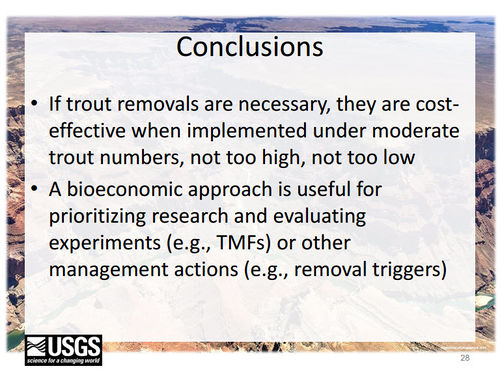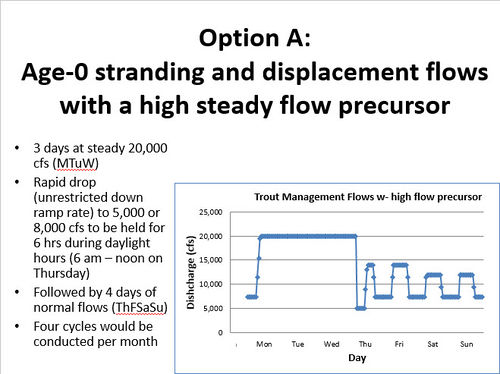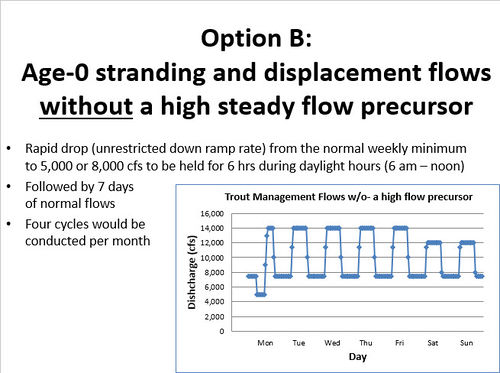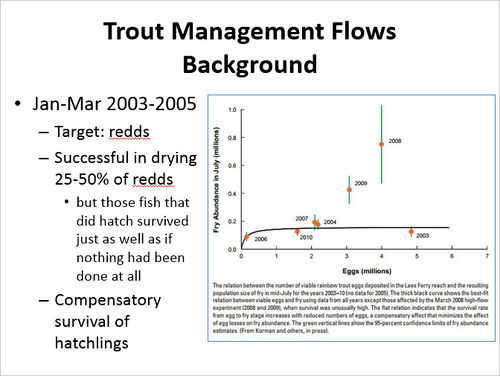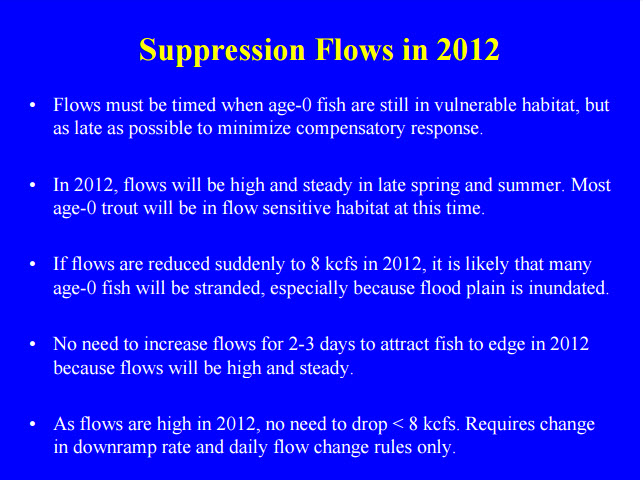|
Experimental Trout Management Flows (TMFs) could be used to control annual
rainbow trout production in the Glen Canyon reach for the purposes of managing
the rainbow trout fishery and for limiting emigration to Marble Canyon and the
Little Colorado River reach. TMFs would be tested early in the experimental
period, preferably in the first 5 years. Under the LTEMP EIS, TMFs could occur from May to August.
LTEMP FEIS Chapter 2, pages 39-40
TMFs are a special type of fluctuating flow designed to reduce the recruitment of trout by
disadvantaging YOY trout (Figure 2-15). TMFs have been proposed and developed on the basis
of research described in Korman et al. (2005). The underlying premise of TMFs is based on
observations that YOY trout tend to occupy near-shore shallow-water habitats to avoid predation
by larger fish. TMFs feature repeated fluctuation cycles that consist of relatively high flows
(e.g., 20,000 cfs) sustained for a period of time (potentially ranging from 2 days to 1 week)
followed by a rapid drop to a very low flow (e.g., 5,000 cfs to 8,000 cfs). This low flow would
be maintained for a period of less than a day (e.g., 12 hr) to prevent adverse effects on the food
base. Low flows would be timed to start in the morning, after sunrise, to expose stranded fish to
direct sunlight and heat. Up-ramp rates to the TMF would be the same as the limit for this
alternative overall (i.e., 4,000 cfs/hr). The down-ramp from peak to base would be over a single
hour (e.g., 15,000 cfs/hr for a drop from 20,000 cfs to 5,000 cfs). In a TMF flow cycle, YOY
trout are expected to occupy near-shore habitat when flows are highest, and would be stranded
by the sudden drop to low flow. Because older age classes of trout tend to occupy deeper habitats
toward the middle of the river channel, they are less susceptible to stranding and are less likely to
be directly affected by TMFs. TMFs would be used to control trout recruitment in the Glen
Canyon reach to manage the rainbow trout fishery, and to limit emigration of juvenile trout to
downstream reaches, particularly to habitat occupied by humpback chub near the confluence
with the Little Colorado River. Triggers for implementation of TMFs would be determined in
consultation with the AZGFD.
It should be noted that several Tribes have expressed concerns about TMFs as a taking of
life within the canyon without a beneficial use. The Pueblo of Zuni has expressed concern that
the taking of life by trout stranding has an adverse effect on the Zuni value system. The jointlead
agencies will continue to work with the Tribes regarding options for trout management.
TMFs may be tested under this alternative early in the LTEMP period, even if not
triggered by high trout recruitment. The intent of these early tests would be to determine the
effectiveness of TMFs in reducing trout recruitment and the emigration of young trout to Marble
Canyon and the Little Colorado River reach. The condition of the trout fishery, as determined in
consultation with AZGFD, and potential impacts on other important resources would be
considered prior to implementing TMFs. If TMFs are determined to be effective for these goals
while minimizing impacts on other resources, they may be deployed on a regular or triggered
basis. TMFs would be tested two to three times in the early part of the LTEMP period while
attempting to minimize confounding effects with other experimental treatments. Tests would
start with a conservative application of two cycles in June and July (Figure 2-15), but could be
increased based on experimental testing to as many as three cycles per month for 3 months (May,
June, and July).
|
|
Lees Ferry Anglers Trout Fishery Recommendations
Recommendation #5.
Under certain conditions, rainbow trout at Lees Ferry have reproduced prolifically. Historically, when there is an over-abundance of young-of-year rainbow trout, the quality and condition of rainbow trout decline. This is likely due to the low quality and low abundance of food sources in Lees Ferry. Trout Management Flows (TMFs) are flow treatments that are hypothesized to reduce the abundance of young-of-year trout by stranding trout shortly after they emerge from their redds (Korman, Ecometric Research, Inc., personal communications, 2015).
We believe the best long term and ecologically appropriate solution to controlling trout densities is to increase invertebrate diversity and manage Grand Canyon Dam flows to avoid excessive trout spawning and recruitment (see recommendations related to the aquatic food base and equalization flows). We are concerned about the collateral damage that TMFs could have on other resources especially the aquatic food base and native fish. TMFs may be especially useful when spring HFE's are implemented or in years when high equalization flows are required.
TMF's should only be implemented in a carefully designed experimental framework that includes quantified criteria for success (for managing trout recruitment and improving the humpback chub population) and the impacts to other resources, especially the aquatic food base, are fully assessed. TMF's should only be used when the rainbow trout population is stable and includes a healthy abundance of all size classes of rainbow trout. Mitigation measures such as emergency stocking of trout need to be in place prior to the implementation of TMFs in case of catastrophic loss to the fishery (see recommendations on Trout Stocking). In conclusion, the experimental evaluation of TMFs needs to recognize the trout fishery as a highly valued asset. The AZGFD should have a seat at the table along with Federal agencies on any discussion and decisions related to implementation of TMFs.
|

